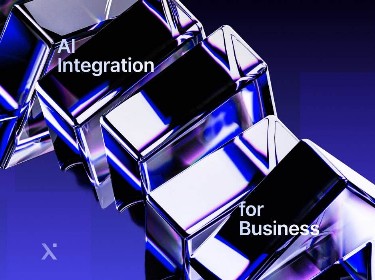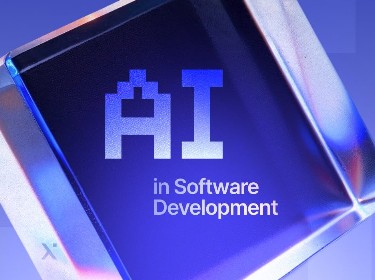Machine learning in automotive is poised to become a fundamental principle for product development processes. As the technology continues to advance, we can expect to see even more innovative and transformative applications.
Estimates project that the global autonomous car market will experience significant growth in the coming years, with a projected size of nearly $62 billion by 2026. This clearly indicates that the automotive sector is one of the most promising industries for machine learning.
While machine learning in the automotive industry is often associated with product innovations such as self-driving cars, parking and lane-change assistance, and smart energy systems, it can also be utilized in various other ways, ranging from improving safety to reducing emissions.
Read on to discover more about ML development in the automotive sector and see how it has become an integral part of advanced product development processes. Learn more about the benefits, limitations, and applications of this innovative tech.
Searching for a reliable AI team? Check out our artificial intelligence service offering
What are the benefits of using machine learning in automotive industry?
![]()
The benefits of using machine learning in automotive include improved safety, enhanced vehicle efficiency and performance, cost reduction, and more environmentally friendly practices. Let’s discuss these in further detail.
Improving safety
Improving safety is one of the most important applications of machine learning in the automotive industry. Machine learning can be utilized to develop advanced driver assistance systems (ADAS) that effectively warn drivers about potential hazards on the road.
The global ADAS market is projected to reach $65.1 billion by 2030, with a CAGR of 9.7%. Factors such as the growing demand for road safety and strong government support have prompted leading original equipment manufacturers (OEMs) to invest in the development of ADAS systems. These systems identify potential hazards and alert drivers to potential dangers by analyzing data from sensors and cameras.
Since its establishment in 2003, Tesla has been at the forefront of adopting machine learning solutions in automotive. Other manufacturers of autonomous vehicles should also leverage diverse data and understand that constructing accurate and unbiased datasets requires significant investment in human-in-the-loop data training and testing. Fortunately, accessing data training services has never been easier.
This is where IT consulting services for the AI and machine learning in automotive industry can play a crucial role, providing expertise on data acquisition, model training, and system integration to ensure the safe and reliable deployment of ML-powered ADAS.
Enhancing vehicle efficiency and performance
By integrating big data analytics and machine learning, the automotive industry has boosted its capacity to process massive volumes of data. This advancement has not only facilitated the development of vehicles and enhanced subsystem performance but also provided valuable insights to guide future product design. Furthermore, it helps identify failure patterns and establish correlations between failures and their causes.
Region-specific factors such as variations in fuel quality, climatic conditions, and road infrastructure are also being taken into account. This consideration has led to the implementation of machine learning systems aimed at developing region-specific customizations to strengthen product reliability. IoT services for the automotive industry can further enhance this by collecting real-time data on vehicle performance and environmental conditions, allowing for even more precise optimization and adaptation.
Reducing costs
ML-based predictive maintenance solutions can assist automotive manufacturers in identifying anomalies in vehicle performance, including engine temperature, oil level, and tire pressure.
By detecting subtle changes, engineers can proactively take measures to minimize downtime, prevent expensive repairs, and ensure the reliability of their vehicles, ultimately leading to higher customer satisfaction.
Furthermore, application of machine learning in automotive can help companies reduce expenses by utilizing the data obtained through predictive maintenance to optimize their processes and minimize resource utilization.
Making the industry more eco-friendly
Machine learning in automotive has the potential to make the industry cleaner and more efficient. By analyzing data on driving behaviors, machine learning algorithms can provide recommendations for optimizing routes and reducing fuel consumption. This can lead to substantial reductions in carbon emissions and cost savings for consumers.
Most importantly, machine learning can play a crucial role in promoting the adoption of alternative fuels. It enables drivers to conveniently watch fuel prices and seamlessly transition between different types of fuels, including alternatives ones. Additionally, machine learning algorithms can enhance energy efficiency during vehicle motion by effectively managing factors such as aerodynamics and engine power.
Overall, machine learning has the capacity to contribute significantly to a more eco-friendly and sustainable future.
Meet Circularr — a blockchain-based plastic recycling network developed by PixelPlex
What are the limitations associated with the application of machine learning in the automotive industry?
While machine learning has significantly transformed the automotive sector into a data-driven industry and become an indispensable decision-making tool, there are certain limitations to its implementation. These include difficulties in data interpretation, data silos, and high maintenance costs.
Data siloed within individual companies
One of the major challenges in implementing ML in automotive is the need for vast amounts of data. Machine learning algorithms require extensive datasets for effective learning and prediction.
Although the automotive industry generates a considerable volume of data, it is often siloed within different organizations or departments. As a result, acquiring the necessary data for training ML models can be a laborious task.
Difficulties of data interpretation
Machine learning models can be challenging to interpret. To make informed selections, automotive decision-makers must understand how they work. However, many ML algorithms are inherently opaque, making it difficult to provide straightforward explanations for their outcomes.
Costly software maintenance
Another limitation is software maintenance, which can be costly in a rapidly evolving sector. With the introduction of new technologies and regulations each year, keeping machine learning models up to date becomes a significant challenge. In order to achieve real progress, automobile manufacturers must allocate substantial resources to the maintenance and updating of their machine learning models and software.
Most popular applications of machine learning in automotive engineering
![]()
Let’s delve deeper into the applications of machine learning in the automotive industry and explore some of its most popular machine learning use cases in automotive industry, including autonomous vehicle technology, anomaly detection, risk prevention, personalized driving experience, on-road assistance, traffic prediction, and route optimization.
Autonomous vehicle technology
The advancement of autonomous vehicles stands as one of the most fascinating applications of ML in automotive R&D. These vehicles use sensors and algorithms to perceive and react to their environment, thereby enhancing safety and efficiency compared to conventional cars.
ML is also being employed in various aspects of the technology used in advanced driver-assistance systems. The role of ADAS is to prevent injuries and fatalities by minimizing the occurrence of car accidents, which are predominantly caused by human error, accounting for approximately 90% of cases. Research indicates that ADAS has already demonstrated significant results, with a 27% reduction in bodily injuries and a 19% decrease in vehicle damage.
ADAS also enhances the predictability of driving and thus promotes a safer driving style. It helps react swiftly, offers effective solutions, and even outperforms humans in addressing blind spots and pulling the emergency brake when required.
In addition to this, vehicles equipped with Automated Driving Systems (ADS) are already capable of performing autonomous maneuvers such as fully automated parking. There are expectations that they will eventually operate without the need for a human driver. Companies like Tesla, Mercedes, and BMW are actively testing and developing vehicles with ADS.
Predictive maintenance
Given that modern vehicles generate vast amounts of operational data, ML is an ideal tool for implementing predictive maintenance strategies.
By leveraging the data provided by the car, these approaches aim to identify potential anomalies that could result in downtime or failure. This shift in maintenance strategies moves away from error-prone models, ultimately improving overall reliability.
Risk prevention
Leading automotive manufacturers are progressively equipping vehicles with solutions to monitor fatigue and driver reaction time. By integrating intelligent software with suitable sensors, the objective is to decrease the number of accidents on the road and mitigate the discomfort of driving in challenging conditions.
For instance, Tesla employs eye monitoring tech to detect signs of driver fatigue and prevent them from falling asleep while driving. This technique utilizes the company’s neural network technology, which analyzes road images for object detection and depth estimation.
Similarly, the BMW 3 Series features a personal assistant that aims to enhance driving safety and comfort.
Do you know how to protect yourself and your data in the web3 space? That's where our ML-powered Web3 Antivirus solution comes into play
Personalized driving experience
To ensure an exceptional customer experience, luxury automobile manufacturer Porsche offers vehicle packages tailored to drivers’ preferences. In order to implement this, over 270 machine learning models were trained for specific markets and derivatives. These models were used to identify patterns in the data, enabling accurate predictions and personalized recommendations for each customer based on their individual choices.
For example, if customers choose “Carmine Red” for their Porsche, the model will then suggest a manual transmission, as previous owners have often selected these two options in combination.
On-road assistance
In the automotive industry, Natural Language Processing (NLP) converts human speech into digital language, enabling smart voice assistants to comprehend and respond to human commands. These assistants help drivers stay connected and informed while keeping their hands on the wheel.
The percentage of cars equipped with in-car connected services is projected to reach 60% by 2024, and it is anticipated that 90% of newly sold vehicles worldwide will have voice assistants by 2028.
The Mercedes Benz User Experience (MBUX) infotainment system continues to be a leading example in in-car voice assistance. The assistant responds to simple voice commands, such as “Turn on the radio.” Users have the option to select from various display styles, including “classic,” “progressive,” “subtle,” or “sporty.”
The system can also remember personal preferences, such as favorite songs or frequently taken routes to work. It leverages this information to suggest favorite radio stations or faster routes with less traffic based on individual habits.
Traffic prediction and route optimization
Numerous studies have been conducted on the application of machine learning algorithms to predict road traffic, and the findings are fascinating.
The studies use the random forest algorithm. As a classifier, the algorithm constructs multiple decision trees and combines their outputs to generate precise predictions. With sufficient training data, it delivers efficient results swiftly. When employed to address traffic congestion, this approach achieves an accuracy rate of 87.5%. In this particular case, weather conditions, time periods, road-specific conditions, road quality, and holidays are used as input variables for the model.
The k-nearest neighbors (KNN) algorithm relies on the principle of feature similarity to predict future values. Experiments conducted using the KNN model demonstrated that it achieved over 90% accuracy in short-term traffic flow prediction.
Furthermore, by leveraging historical and real-time data, ML algorithms can identify patterns, optimize routes, and continuously improve their performance.
ML algorithms can analyze the most up-to-date traffic conditions, weather forecasts, and social media feeds to make instant decisions. They can assist in dynamic route planning by adjusting routes based on changing delivery windows or taking into account customer preferences.
Check out top 10 ML applications in business and see what this tech can offer your company
Final thoughts
The machine learning use cases in automotive have revealed the untapped potential of enterprise data. It is clear that a good technique is essential to unlock the value hidden within this data. That’s where PixelPlex machine learning consulting services come in.
PixelPlex advises on ML app development and helps build machine learning applications for both startups and enterprises. Whether it’s designing ML models to predict outcomes and providing computer vision development services to uncover insights, we have the expertise to remove any obstacles that stand between you and business growth.
By introducing robust technical vision, feasible architectures, and flexible software, we can help you resolve operational and conceptual issues, simplify facility management, and remove limitations on business expansion.
If you’re looking to leverage the power of machine learning in your automotive endeavors, don’t hesitate to reach out to PixelPlex.




